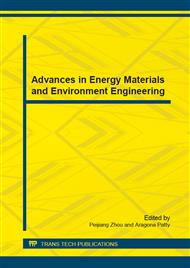[1]
M. Gavrilescu, L.V. Pavel, I. Cretescu. Characterization and remediation of soils contaminated with uranium [J]. Journal of Hazardous Materials 163 (2009) 475–510.
DOI: 10.1016/j.jhazmat.2008.07.103
Google Scholar
[2]
B.A. Napier, P.R. Reed, Alternative Conceptual Models for Assessing Food Chain Pathways in Biosphere Models, Pacific Northwest National Laboratory, U.S. Nuclear Regulatory Commission Office of Nuclear Regulatory Research, Washington, DC, (2006).
Google Scholar
[3]
Groudeva V I, Vasilev D V, Karavaiko G I, et al. Changes in an Ore Dump During a 40-Year Period of Commercial-Scale and Spontaneous Natural Bioleaching[J]. Advanced Materials Research, 2009, 71: 373-376.
DOI: 10.4028/www.scientific.net/amr.71-73.373
Google Scholar
[4]
Groudev S N, Spasova I I, Georgiev P S. In situ bioremediation of soils contaminated with radioactive elements and toxic heavy metals[J]. International journal of mineral processing, 2001, 62(1): 301-308.
DOI: 10.1016/s0301-7516(00)00061-2
Google Scholar
[5]
Tikilili P V, Nkhalambayausi-Chirwa E M. Characterization and biodegradation of polycyclic aromatic hydrocarbons in radioactive wastewater[J]. Journal of hazardous materials, 2011, 192(3): 1589-1596.
DOI: 10.1016/j.jhazmat.2011.06.079
Google Scholar
[6]
Tate R L, Klein D A. Soil Reclamation Processes Microbiological Analyses and Applications[M]. CRC Press, (1985).
Google Scholar
[7]
Lloyd J R. Microbial reduction of metals and radionuclides[J]. FEMS microbiology reviews, 2003, 27(2‐3): 411-425.
DOI: 10.1016/s0168-6445(03)00044-5
Google Scholar
[8]
McLean R J C, Fortin D, Brown D A. Microbial metal-binding mechanisms and their relation to nuclear waste disposal[J]. Canadian Journal of Microbiology, 1996, 42(4): 392-400.
DOI: 10.1139/m96-055
Google Scholar
[9]
Anderson R T, Lovley D R. Microbial redox interactions with uranium: an environmental perspective[J]. Interactions of microorganisms with radionuclides. Elsevier Science Limited, Amsterdam, The Netherlands, 2002: 205-223.
DOI: 10.1016/s1569-4860(02)80036-5
Google Scholar
[10]
Lin Ying, Gao Bai, Li Yuanfeng. Low concentration of uranium nuclear industry wastewater treatment technology progress[J]. Shandong chemical industry, 2009, 38(3): 35-38.
Google Scholar
[11]
Handbook of groundwater remediation using permeable reactive barriers: applications to radionuclides, trace metals, and nutrients[M]. Academic Press, (2002).
DOI: 10.1016/b978-012513563-4/50005-0
Google Scholar
[12]
Shen Lei, Zhang Taiping, Jia Xiaoshan. Journal of Sun Yat-sen University: Natural Science, 2005, 44(2): 111~115.
Google Scholar
[13]
Yang Yu, Zhang Yanfei, Huang Jufang, Jang Donghai. The preservation methods of Acidithiobacillus ferrooxidans[J]. Journal of central south university (natural science edition). 2006(06).
Google Scholar
[14]
Soil Science Society of China Agricultural Chemistry Committees. Conventional methods of soil agricultural chemistry, Beijing: Science Press, (1983).
Google Scholar
[15]
Alberts J J, Muller R N. The distribution of 239, 240Pu, 238Pu, and 137Cs in various particle size classes of Lake Michigan sediments. J Environ Qual, 1979, 8(1): 20~22.
DOI: 10.2134/jeq1979.00472425000800010005x
Google Scholar
[16]
The state environmental protection standards. Intends to open the site acceptable levels of residual radioactivity in soil (provisional, HJ53-2000). Beijing: China Environmental Science Press, (2000).
Google Scholar
[17]
YangYuee, Gu Zhijie, Wang Zhiming. U.S. radioactive contaminated sites remediation cleaning levels in the soil[J]. Radiation protection communication, 2007, 27(2): 8~12.
Google Scholar
[18]
Zhang Lanlan, Zou Ping, Wei Yunlin, Zhang Wenbin. A strain of Thiobacillus ferrooxidans system evolution analysis as well as the effect of leaching mining research[J]. Mining and Engineering 2008(08).
Google Scholar
[19]
Gavrilescu M, Pavel L V, Cretescu I. Characterization and remediation of soils contaminated with uranium[J]. Journal of Hazardous Materials, 2009, 163(2): 475-510.
DOI: 10.1016/j.jhazmat.2008.07.103
Google Scholar
[20]
Bihari Á, Dezső Z. Examination of the effect of particle size on the radionuclide content of soils[J]. Journal of environmental radioactivity, 2008, 99(7): 1083-1089.
DOI: 10.1016/j.jenvrad.2007.12.020
Google Scholar


